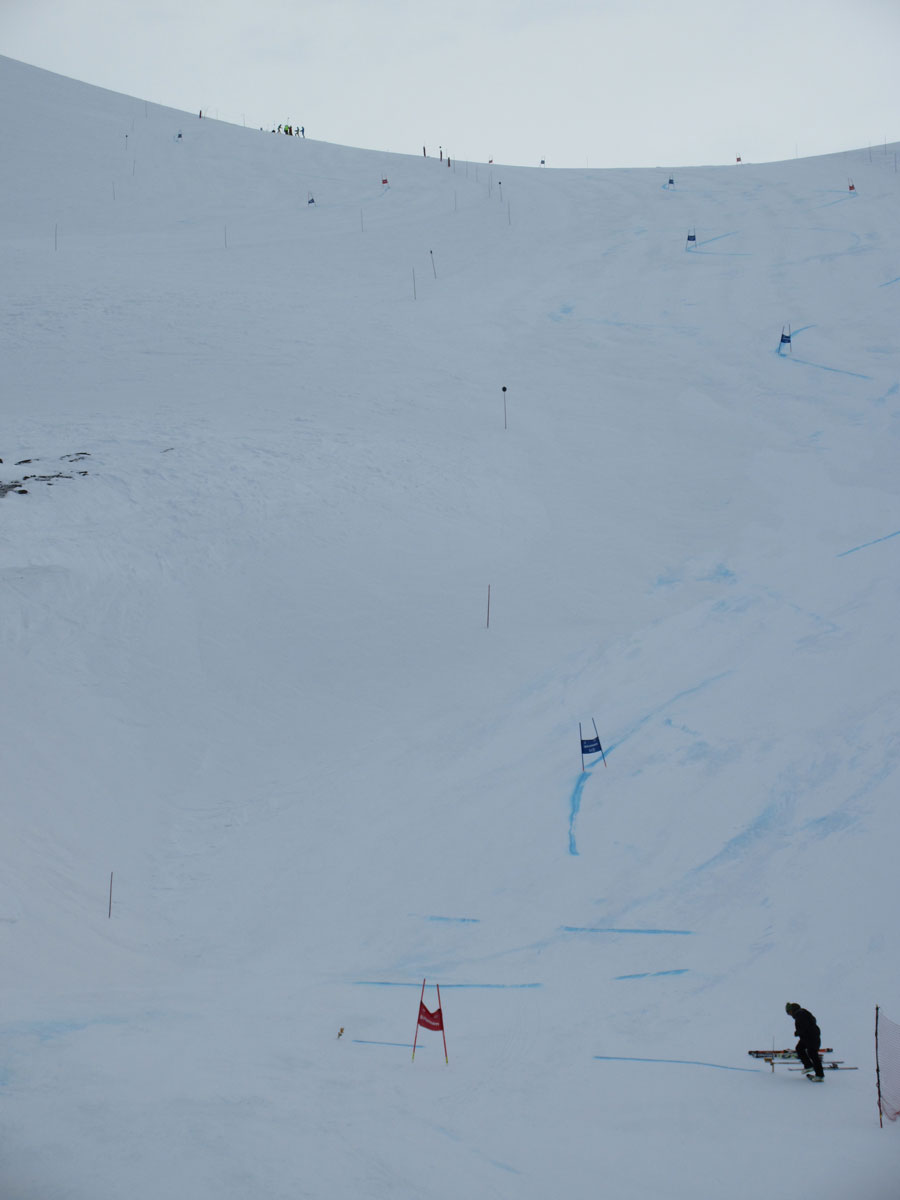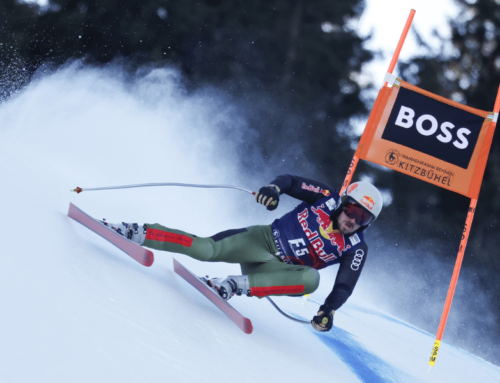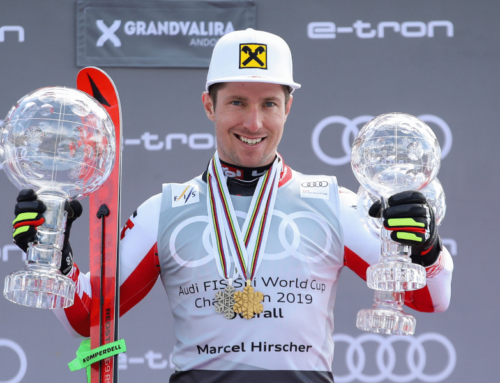Traversing the Andes Pipeline
It’s September 20, 2015, in the only spot for serious ski racers to be this month: Chile.
More than sixty switchbacks and 2,500 meters above Santiago are three of the best race training venues in the Southern Hemisphere: Valle Nevado, El Colorado and La Parva. National teams from across the globe make this annual pre-season trek to Chile in order to jump-start their on-snow training.

Super G training
The men and women of the U.S. Ski Team’s Europa Cup squad, along with invitees from the National Training Group (NTG) are training here in Valle Nevado. Two lift rides away, the men’s Development Team (D-Team) trains in La Parva.
Together, with their coaches and service reps, these athletes make up the critical pipeline to the U.S. World Cup team. Though not the only way to land a coveted berth on the tour, this pipeline provides the main flow.
The Pipeline: A Pyramid of Support
USST Men’s Head Coach Sasha Rearick underscores the vital role these athletes play and the importance of the multi-level structure supporting the World Cup team.
“To me, this is like the building blocks of a pyramid,” he says, “providing a foundation with a large base of support from the bottom to the top. With the NTG, the D-Team and Europa Cup Team, we’ve created a ‘home’ for each athlete. This structure provides a place for every athlete’s development stage, all the way to the World Cup.”
Inside the “B-Net”
SkiRacing.com was on the hill in Chile and spoke with both athletes and coaches to hear firsthand the passion needed to get into the pipeline, the dedication it takes to keep your spot, and the commitment required to advance onto the World Cup Team.
A typical training day in Chile begins at 7 a.m. with freeskiing warm-up and drills and a double session of speed and tech, followed by dryland training, video analysis and team meetings.
Then, it’s re-boot and repeat for the next few weeks.
From the Athletes: Turning Points, Challenges and Confidence
SkiRacing.com: Was there a turning point in your ski racing where you believed a spot on the U.S. Ski Team was possible?
Breezy Johnson, Women’s D-Team: “The turning point was when I became an FIS athlete; that’s a really hard step to make, and doing well in FIS is validation that what you did when you were young wasn’t a fluke.”
SkiRacing.com: Results aside, is there a personal trait that helped you land a spot on course to the World Cup Team?
Sam DuPratt, Men’s D-Team: “Chad Wolk and John Buchar taught me that you have to take your own path — to copy someone else exactly is a fantasy. To be great, you have to be different.”
Jennie Symons, NTG: “My ability to adapt and determination has played a large role.”

Jennie Symons trains slalom in Chile.
Erik Arvidsson, Men’s C-Team: “It all comes down to work and fun. You’re never going to be good at something unless you put in the work, and you’re never going to want to work at something unless you love it.”
SkiRacing.com: What are some of the challenges you face training at such a high level?
Brennan Rubie, Men’s C-Team: “For me, the biggest challenge has been keeping the little things in perspective. Whether it’s results or how each day has gone. Controlling the controllable is an everyday task.”
Keely Cashman, NTG: “The workload definitely increased! Physically, it became more demanding with double sessions and a lot more days on snow. Not only does this affect your physical state, but you have to stay mentally strong.”
SkiRacing.com: Competitive success has a lot to do with confidence. How do you develop that confidence?
Tricia Mangan, Women’s D-Team: “By trying to create the same training environment as the racing environment so that when I’m in the start I don’t feel like I need to do anything special, just ski how I do in training.”
Stephanie Lebby, Women’s D-Team: “I develop confidence through repetition. The more I do something, the more confident I get. I take as many runs a day as possible.”
SkiRacing.com: What are you learning from this experience — about yourself, your teammates and the program?
Sam Morse, Men’s D-Team: “It’s just you standing in that start gate; it’s up to you how you’ll perform. As for my teammates, we have learned to hold each other closer after this past year’s event in Austria [an avalanche that killed Ronnie Berlack and Bryce Astle]. Remembering that we are all just people going through this crazy world together. We’re stronger when we stand together.”

Sam Morse trains slalom.
Alice Merryweather, Women’s D-Team: “This is my first year with the team. I’m still adapting to this new environment. I’ve learned how to push myself harder than ever before.”
AJ Ginnis, Men’s C-Team: “You have to be able to work and create a good training environment with your teammates. For example, last year Mark Engel and I were able to create a great training environment despite having completely different views and ideologies about ski racing.”

AJ Ginnis trains slalom.
SkiRacing.com: If a young racer asked your advice on making the team, what would you tell them?
Mark Engel, Men’s C-Team: “Forget about your expectations and any pressure you feel from coaches, parents, or other athletes. The only pressure you need to feel is from within, and your only goal should be to do as good as you can do — no more, and no less.”

Mark Engel trains super G.
Drew Duffy, Men’s C-Team: “Set realistic goals for yourself that you know you can achieve. But also don’t be afraid to dream and set some goals that may not be realistic. Just know that in order to achieve those goals you are going to have to work hard and dedicate yourself to becoming better.”
From the Coaches: Expectations and Advice
SkiRacing.com: As coaches, what do you look for in potential U.S. Ski Team candidates?
Ian Lochead, Head Coach, Men’s Europa Cup Team: “Good fundamentals, skiing fast and in balance on tough courses without being at risk, and with a high finish/success rate. Pushing harder, even while winning, like Ligety. Confidence is huge! Striving for unattainable improvement — this is the driving force of a true champion.”
Frank Kelble, Head Coach, Woman’s Europa Cup/Development Team: “Attitude and atmosphere equal a positive training environment. We want kids that love skiing, that are passionate about going out there everyday — regardless of conditions — and who want to go all day until you pull them off the hill. They have the heart and soul of the sport.”
SkiRacing.com: Once in the pipeline, how do athletes advance to the next level?
Randy Pelkey, Head Coach, Men’s D-Team: “Our job is to create an environment for them to advance themselves. We guide them by honing their skills: teaching them personal responsibility, showing them how to become better athletes for the long term. We don’t choose them, they choose themselves through doing the work.”
Thomas Erhard, Head Coach, FIS Women’s NTG: “We give the athletes the tools to be in charge of their own success. This helps develop independence and confidence. A strong work ethic and positive attitude can overcome technical deficiencies.”
SkiRacing.com: Making the U.S. Ski Team is a dream for many young racers. What realities do they need to understand early on?
Justin ‘JJ’ Johnson, Assistant Coach Men’s D-Team: “You need to make behavioral changes now. Self-sufficiency is critical: awareness and attention to detail of what’s needed to take care of yourself and your equipment during a typical training day is an essential requirement. Be ready — being here is a life lesson!”
Frank Kelble, Head Coach Woman’s Europa Cup/Development Team: “You have to be able to train at a very high level — it’s a heavy workload. This can be a shock for those coming in from outside the ‘pipeline’. Off-season preparation is key — it’s a year-round sport.”
Kris Shampeny, Europa Cup/Development Team Assistant Coach: “You need to challenge yourself, push yourself, and get outside of your comfort zone.”
Karin Harjo, Europa Cup/Development Team Assistant Coach: “Making the U.S. Ski Team is just the beginning; it’s not an outcome. You have to be ready to work harder than you ever have!”
And one final piece of advice from Brennan Rubie…
“Send it!”























